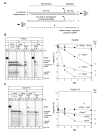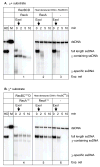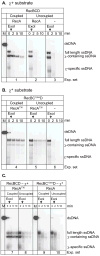A RecA mutant, RecA(730), suppresses the recombination deficiency of the RecBC(1004)D-chi* interaction in vitro and in vivo
- PMID: 17141804
- PMCID: PMC1847798
- DOI: 10.1016/j.jmb.2006.10.090
A RecA mutant, RecA(730), suppresses the recombination deficiency of the RecBC(1004)D-chi* interaction in vitro and in vivo
Abstract
In Escherichia coli, homologous recombination initiated at double-stranded DNA breaks requires the RecBCD enzyme, a multifunctional heterotrimeric complex that possesses processive helicase and exonuclease activities. Upon encountering the DNA regulatory sequence, chi, the enzymatic properties of RecBCD enzyme are altered. Its helicase activity is reduced, the 3'-->5'nuclease activity is attenuated, the 5'-->3' nuclease activity is up-regulated, and it manifests an ability to load RecA protein onto single-stranded DNA. The net result of these changes is the production of a highly recombinogenic structure known as the presynaptic filament. Previously, we found that the recC1004 mutation alters chi-recognition so that this mutant enzyme recognizes an altered chi sequence, chi*, which comprises seven of the original nucleotides in chi, plus four novel nucleotides. Although some consequences of this mutant enzyme-mutant chi interaction could be detected in vivo and in vitro, stimulation of recombination in vivo could not. To resolve this seemingly contradictory observation, we examined the behavior of a RecA mutant, RecA(730), that displays enhanced biochemical activity in vitro and possesses suppressor function in vivo. We show that the recombination deficiency of the RecBC(1004)D-chi* interaction can be overcome by the enhanced ability of RecA(730) to assemble on single-stranded DNA in vitro and in vivo. These data are consistent with findings showing that the loading of RecA protein by RecBCD is necessary in vivo, and they show that RecA proteins with enhanced single-stranded DNA-binding capacity can partially bypass the need for RecBCD-mediated loading.
Figures





References
-
- Spies M, Kowalczykowski SC. Homologous recombination by RecBCD and RecF pathways. In: Higgins NP, editor. The Bacterial Chromosome. ASM Press; Washington, D.C.: 2005. pp. 389–403.
-
- Dillingham MS, Spies M, Kowalczykowski SC. RecBCD enzyme is a bipolar DNA helicase. Nature. 2003;423:893–7. - PubMed
-
- Dixon DA, Kowalczykowski SC. Homologous pairing in vitro stimulated by the recombination hotspot, Chi. Cell. 1991;66:361–71. - PubMed
Publication types
MeSH terms
Substances
Grants and funding
LinkOut - more resources
Full Text Sources
Molecular Biology Databases

